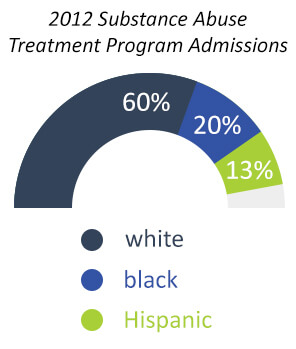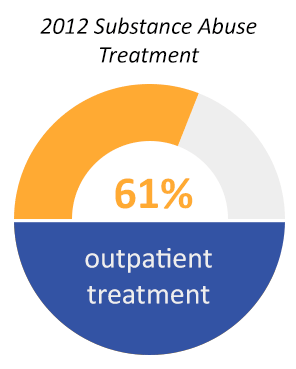Rehab Guide for Families Part II: Treatment and Recovery
Researching Your Treatment Options

At times of emotional conflict, it might seem that the family is just a set of isolated individuals who happen to live under the same roof, but this is far from true. The family is a deeply interconnected system in which each member’s actions can either undermine or support the others. Getting help for an addicted family member can be difficult, especially if other members of the household feel angry or ashamed, or if they are in denial about the problem.
It is very common for people to feel alone when they discover that their parent, child, or partner is struggling with addiction. In fact, addiction affects families from all economic, racial, and ethnic groups. According to the Treatment Episode Data Set (TEDS) report of 2002-2012, 60 percent of individuals admitted to treatment programs for substance abuse in 2012 were white, while 20 percent were black and 13 percent were Hispanic.
Levels of Substance Abuse Treatment
There are many different levels of substance abuse treatment, from outpatient centers to inpatient hospital programs to long-term residential treatment facilities. During the course of recovery, a client may enter at a more intensive, closely supervised form of care before graduating to a level of treatment that allows more autonomy and independence. This process will vary according to a client’s needs; however, the levels of care generally include the following:
Outpatient programs, also known as ambulatory services, are among the most common choices for individuals with a shorter history of substance abuse, a high level of motivation to participate in recovery activities, and work or family obligations that prevent them from committing to inpatient rehab. Inpatient programs are often recommended for individuals who have a severe history of substance abuse, who need close monitoring during the detox and rehab process, or who have multiple addictive disorders or co-occurring medical conditions.

The TEDS report of 2002-2012, which tracks patterns in substance abuse treatment in the US, notes that outpatient recovery is the most popular approach to treatment in the country, with 61 percent of Americans admitted for treatment in 2012 receiving ambulatory services. By comparison, 17 percent of admissions were for residential rehab, and 22 percent were for detox services only. However, it’s important to remember that the choice of a treatment center is a highly personalized decision, based on various factors, such as:
- The client’s medical history and physical condition
- Severity of substance abuse
- Multiple substance addictions
- Co-occurring psychological conditions
- Family responsibilities
- Occupational or social obligations
The choice of a treatment facility should be made in partnership with a therapist, physician, or other health professional, along with the family. As you research the treatment options available to you, the following checklist can help you and your loved ones determine your needs and priorities. Rate the following factors on a scale of 1 to 10, with 1 being the least important attribute or quality, and 10 being the most important:

Paying for Rehab Treatment
 When it comes to selecting a treatment program that can address the impact of addiction on a family, there are many elements that should take priority over the cost of treatment. However, the reality is that the cost of treatment and the client’s financial resources are deciding factors in many clients’ choice of a treatment program. The availability of personal savings, health insurance coverage, or government-funded programs can also affect a family’s decision about where to seek treatment.
When it comes to selecting a treatment program that can address the impact of addiction on a family, there are many elements that should take priority over the cost of treatment. However, the reality is that the cost of treatment and the client’s financial resources are deciding factors in many clients’ choice of a treatment program. The availability of personal savings, health insurance coverage, or government-funded programs can also affect a family’s decision about where to seek treatment.
Long-term residential rehab, which can last for months, is generally more expensive than partial hospitalization or outpatient treatment because of the cost of 24-hour staffing, housing, meals, recovery activities, amenities, and other expenses. Partial hospitalization programs and outpatient treatment are less costly, and programs are usually shorter, lasting from 4-6 weeks, on average. In addition, outpatient care may be easier to fund through health insurance plans.
Understanding the Treatment Process
If you understand what a loved one is going through in treatment, it can be easier to provide the emotional support they need at this time. In detox and rehab, clients confront not only the physical demands of getting clean and sober, but also the mental challenges of facing and overcoming their addiction.
Although it’s important to be aware of a loved one’s schedule in rehab, a list of activities doesn’t reveal the whole story of what clients experience in recovery. A comprehensive rehab program gives clients the means to make profound changes in their lives, restoring health to the body and mind. Yet the process of making those changes can be challenging. In sobriety, people often experience emotions that they have suppressed with drugs or alcohol, and emotions like the following can leave a loved one feeling exhausted or confused:
- Fear of the future
- Anger at partners or relatives
- Guilt over past actions
- Ambivalence about getting sober
- Grief over personal losses
Family members should not expect recovery to happen quickly; it can take months, or more likely years, for suppressed emotions and grudges to be resolved. A recovery program should provide the tools that clients need to begin working through these feelings, such as in-depth work with a therapist, support from peers who are also in recovery, and an opportunity to explore spirituality as a means of growth. Access to therapeutic groups, educational courses, and 12-Step programs will also increase self-awareness and help clients handle potentially painful feelings.
Individuals who are experiencing withdrawal from intoxicants, or who are working to rebuild their lives in the aftermath of addiction, can experience depression, anxiety, mood swings, or sudden outbursts of anger. For the loved ones of people in recovery, the guidance of an experienced family therapist or marriage counselor can be invaluable. In order to have a lasting effect on the health of a family, therapy must address the dysfunctional coping patterns, flawed communication styles, and boundary issues that may have contributed to an atmosphere of addiction, notes the Substance Abuse and Mental Health Services Administration (SAMHSA).
How Does Family Therapy Work?
If the family is to grow stronger, and the home is to become stable enough to sustain sobriety, substance abuse must be addressed as a family issue. Family therapy sessions are conducted as part of a comprehensive rehabilitation program, and they may be held on a one-to-one basis or with all family members present. In addition, the loved ones of rehab clients have the opportunity to participate in support groups with other individuals whose relatives are in treatment. Peer support programs like Al-Anon and Alateen are also available as a source of strength and hope for individuals whose loved ones are in rehab.
Family therapy sessions are led by professionals who have specialized training in substance abuse treatment, such as a graduate degree in counseling, social work, or psychology. These therapists should be licensed or certified in their field, and they should have additional credentials in the area of addiction treatment.
The idea of attending therapy sessions is intimidating to a lot of people. Family counselors often hear objections to therapy from the parents, adult children, or spouses of individuals suffering from substance abuse. Statements like, “I’m not the one with the problem,” or “None of this is my fault,” are quite common in therapy sessions. But individual and group therapy sessions have actually led many individuals to examine the behaviors and thought patterns that contribute to substance abuse in the home, ultimately creating a more stable, supportive environment.
Although the primary focus of therapy is typically on the individual who is going through rehab, therapeutic strategies are designed to support every member of the family, so the unit as a whole emerges stronger and long-term sobriety can be sustained.
The Family’s Role in Recovery from Addiction
 In spite of the coping strategies, social services, and resources that rehab provides, the family is still one of the greatest sources of support for a person going through recovery. According to the Journal of Psychoactive Drugs, family involvement in the recovery process has consistently proven to be one of the most significant factors predicting long-term abstinence after rehab. Listed below are some of the actions family members can take to maximize the benefits of rehab and promote long-term abstinence from drugs and alcohol:
In spite of the coping strategies, social services, and resources that rehab provides, the family is still one of the greatest sources of support for a person going through recovery. According to the Journal of Psychoactive Drugs, family involvement in the recovery process has consistently proven to be one of the most significant factors predicting long-term abstinence after rehab. Listed below are some of the actions family members can take to maximize the benefits of rehab and promote long-term abstinence from drugs and alcohol:
- Attend family and/or marriage counseling sessions as recommended by the client’s treatment team.
- Encourage the loved one in rehab by maintaining a positive attitude about recovery.
- Seek out opportunities for education about substance misuse, addiction, and recovery.
- Be willing to address any conflicts, emotional barriers, or resentments that might interfere with a sober environment at home.
- Be prepared to create an atmosphere that’s conducive to long-term sobriety by removing addictive substances from the home and making other changes recommended by the client’s rehab program.
- Take part in alumni activities, workshops, and family weekends after the client completes the rehab program.
Family members must be aware of the possibility that they may resent their loved one for bringing painful issues to the surface. However, these uncomfortable feelings can be resolved if the family is willing to participate wholeheartedly in the therapeutic process. Throughout the recovery journey, family members should remember that the discomfort or pain that arise in therapy can ultimately lead to stronger, healthier, more trusting relationships.
The Difference between Supporting and Enabling
For most of us, the impulse to help someone we love — whether it’s a blood relative, a close friend, or an intimate partner — comes naturally. But when it comes to addiction, that impulse to provide help and support can become distorted into a form of dysfunctional behavior called “enabling.” According to Psychology Today, family members must learn to draw the line between empowering a loved one who’s suffering from addiction and enabling the destructive behavior to continue.
Consistently making it possible for a loved one to abuse drugs or alcohol can result in codependency, a state in which the individual comes to rely on the loved one’s addiction for a sense of control, power, or security. While the codependent person may not abuse alcohol or drugs, they can become dependent on the loved one’s addiction for a sense of self-esteem or a feeling of emotional stability.
One of the most important aspects of the recovery process — not just for the individual suffering from addiction, but for everyone in the home — is to learn the difference between empowering and enabling. Here are a few differences to keep in mind when you’re faced with a choice about how to help someone in recovery:
Life After Rehab
What can a family expect when a relative or partner comes back from rehab? Although the recovery process may begin with treatment, it continues for months or years after rehab ends. The National Institute on Drug Abuse reminds us that while the symptoms of substance abuse can be treated and managed, addiction is a chronic brain disease that cannot be permanently “cured.” Like other chronic conditions, including heart disease, diabetes, or arthritis, addiction requires a significant change in lifestyle in order to prevent a recurrence of symptoms. Consistent application of the coping strategies learned in rehab, combined with the encouragement and compassion of a strong support system, is necessary to prevent relapse.
Family members should be aware of the possibility that their loved one may be dealing with difficult emotions that were suppressed by drugs or alcohol. They may still experience the urge to drink or use drugs, or have trouble handling stressful situations. Patience and compassion are necessary to cope with these behaviors when they occur. At the same time, it should be clear to the individual in recovery that abusive behavior, manipulation, lying, and substance abuse will not be tolerated. Some therapists recommend that the individual in recovery sign a contract with the family to clarify boundaries and expectations once the individual is living at home again.
What to Expect from a Rehab Program
 Family members should never feel that they are all alone after rehab ends. To promote long-term abstinence and provide ongoing support, comprehensive recovery programs include a phase called “aftercare.” In aftercare, clients who have completed the initial stages of rehab can continue to participate in recovery activities and obtain support from their treatment team, even while they are staying in private residences or sober living homes. Families can participate in the aftercare process by continuing to attend therapy sessions, alumni weekends, or workshops with the person who has completed rehab.
Family members should never feel that they are all alone after rehab ends. To promote long-term abstinence and provide ongoing support, comprehensive recovery programs include a phase called “aftercare.” In aftercare, clients who have completed the initial stages of rehab can continue to participate in recovery activities and obtain support from their treatment team, even while they are staying in private residences or sober living homes. Families can participate in the aftercare process by continuing to attend therapy sessions, alumni weekends, or workshops with the person who has completed rehab.
Families should expect that a rehab program will provide referrals to resources in the community that can support the recovery process, such as 12-Step groups, spiritual centers, therapists, social workers, or healthcare providers who specialize in substance abuse treatment. These resources should be available not only for the person who has finished rehab but also for everyone in the household who needs and wants support.
Although there’s no known cure for the disease of addiction, there are services and resources available to manage this condition and provide sources of strength and healing. The list of resources below can help families who are seeking information or support when faced with the challenges of substance abuse.
Resources for Families with Addiction
